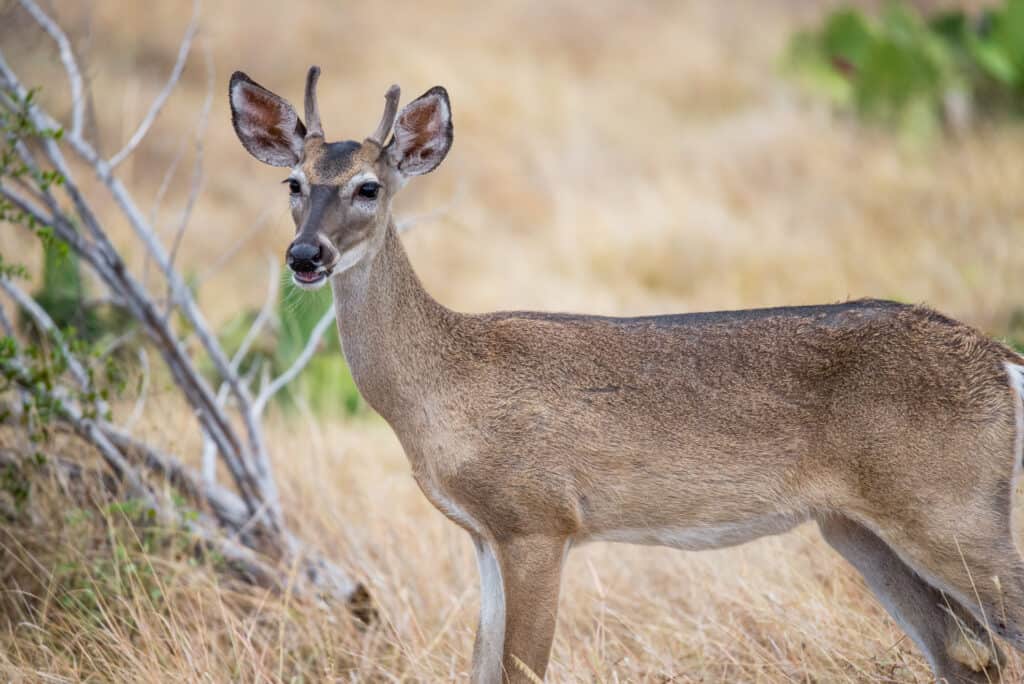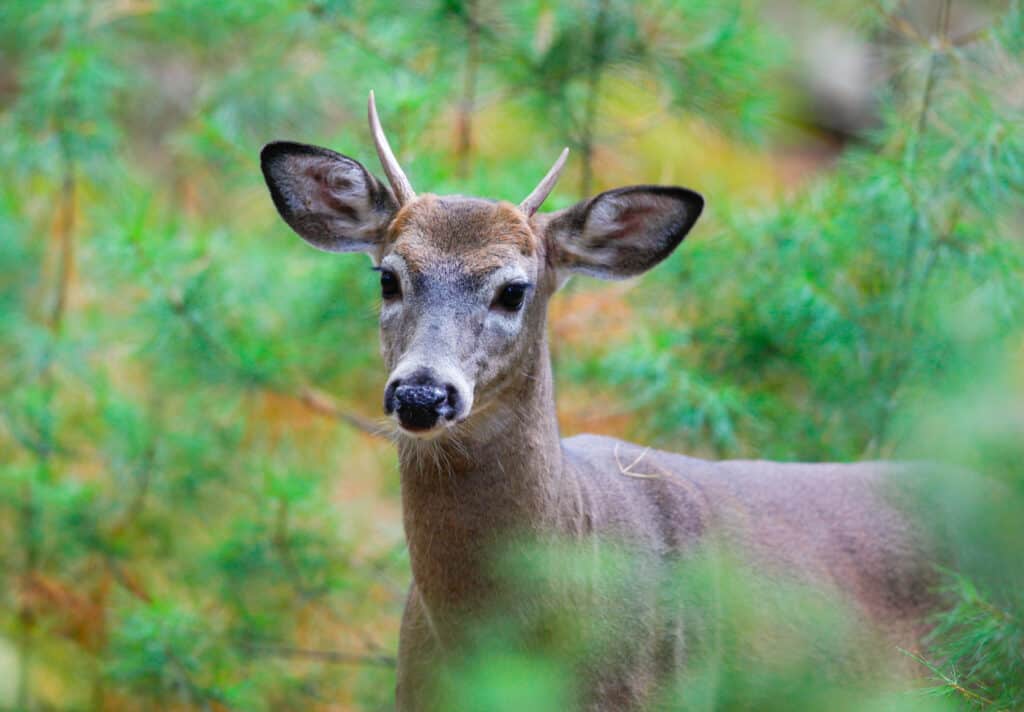Have you ever heard the term “spike” regarding deer? Even if you haven’t, we promise it’s something you want to know if you’re a deer enthusiast! This isn’t just a deer species, as one may think. It’s a term used when referring to certain deer (which may belong to any deer species) with a unique feature. So what’s this all about? Keep reading, and you’ll find out!
What Is a Spike Deer?

The term “spike” refers to bucks (male deer) with antlers that do not branch.
©iStock.com/GizmoPhoto
The term “spike” refers to bucks (male deer) with antlers that do not branch. They are also called spikehorn, spike bucks, spiked bucks, spikes, or spikers. Bill Armstrong, in his paper called “Understanding Spike Buck Harvest,” defines “spike” as “a male deer that is 1.5 years of age or older and whose antlers are unbranched.” Moreover, he mentions that “spike” does not refer to fawns with bumps on their heads.
Are Spikes Indeed Bucks?
While scientific sources use the term “spike” regarding bucks, many hunters do not consider spikes bucks. Why? Because people often believe spikes haven’t reached adulthood, hence they cannot be called bucks yet.
Since spikes are most often 1-1.5-year-old deer, it’s only natural many hunters don’t use this word for bucks. Deer are usually fully grown when they reach 3-4 years old. Besides this, their antlers can still reach their true size and become branched, so there’s still time for them to become true adult bucks. On the other hand, a study shows that deer antlers can grow only until the buck reaches 6.5 years of age. After this, their quality will start decreasing.
Why Are There Spike Bucks?

Unbranched antlers may be caused by bad nutrition, harsh weather conditions, and stress.
©iStock.com/Louise Wightman
A quick Google search will tell you that the development of a buck’s antlers highly depends on how and when the male fawn was born. If it was born later than usual, its antlers might not develop branches. Besides this, unbranched antlers may also be caused by bad nutrition, harsh weather conditions, and stress. For instance, if the male fawn doesn’t get the required nutrients during its first year, it will likely become a spike buck the next year. As per this study, good deer nutrition means a 16% protein diet, which provides enough calcium and phosphorus supplements.
However, if we look into more details, we’ll find out that the antler growth rate depends more on genetics than on any other external conditions. For example, some deer may have a genetic potential to grow big antlers while others don’t. This potential is conditioned by external conditions, including weather and nutrition. If a deer can genetically grow big antlers, they still won’t grow if the nutrition is poor. In contrast, if the deer don’t have the genetic potential to grow large, branched antlers, no amount of highly nutritional food will help its antlers grow. At least that’s what the study above confirms (keep reading to find out if this is indeed true!).
At the same time, the study (which contains conclusions based on research on over 20 generations of deer) also states that the time of birth doesn’t affect antler development, contrary to what we can read on different online sources. As long as the fawn has a proper diet, it will grow antlers, whether born on time or later.
The key point here is that fawns born extremely late, meaning in August or September, may eventually become nutritionally deprived because autumn and winter are close, food is becoming scarce, and their energy needs to register growth. In short, during this period, their energy is used to grow and maintain body tissues first, and there’s no energy left for antler growth. That’s it – no mysteries, just biology, and cause-and-effect!
Should You Remove Spike Deer From the Herd?

It is believed that spike deer should be given a chance to fully mature and prove they’re also worth it.
©iStock.com/Lightwriter1949
If you’re a deer herd owner, you’re probably wondering whether you should keep a spike deer in the herd or allow bucks with fully-grown antlers to breed. While it’s entirely up to you, the Texas Parks and Wildlife Department highly recommends removing spike deer from the herd if you want to have deer with big antlers. Unfortunately, spike deer aren’t as “sought for” as others. Removing young deer with poor antler potential will decrease the risk of more spike deer in the herd. That’s because the ability to grow antlers is a genetic potential and can be further passed to fawns.
However, there’s another side to this recommendation. Larry Weishuhn, who has helped the Texas Parks and Wildlife Department in their study on spike deer, later stated in an interview that, while years ago he was sure that removing spike deer from the herd was the best choice, he’s now reconsidered his position.
He stated that his first suggestion would be to start improving their nutrition to allow bucks to grow and mature. He had the possibility to observe some ear-tagged yearling spike bucks, which had adequate nutrition, and noticed that all produced from “acceptable” to big racks. Moreover, he tagged some late-born buck fawns to follow their antler growth, and all fawns had spike antlers. However, contrary to what people believe, all were able to grow normal antlers until the age of five.
So, based on these details, we do not recommend shooting spike deer. Instead, we believe they need to be given a chance to fully mature and prove they’re also worth it!
How Rare Are Spike Deer?
Spike deer are more common than one would think. Compared to fork-antlered yearlings (meaning deer with branched antlers or, scientifically speaking, a deer that has two or more distinct points), spike deer are a minority. However, in some regions, they may be more common than fork-antlered yearlings.
This study has presented some data grouped by ecological region based on the 1989-1990 white-tailed deer harvest. This could help get a general idea of how rare (or common) spike deer are.
| Pineywoods | Gulf Prairies | Post Oak Savannah | Cross Timbers | South Texas Plains | Edwards Plateau | Rolling Plains | |
|---|---|---|---|---|---|---|---|
| Spike Deer % | 31.1 | 28.2 | 22.6 | 24.5 | 66.9 | 46.3 | 34.4 |
| Forked Deer % | 68.9 | 61.8 | 77.4 | 75.5 | 33.1 | 53.7 | 65.6 |
Of 1017 deer, 37.2% were spike deer, and 62.8% were forked deer. As you can see, in some ecological regions, spike deer were much rarer than forked deer (in Post Oak Savannah, for instance), while other regions hosted a higher number (Edwards Plateau or South Texas Plains).
Up Next:
- Female Deer Name and Behavior Explained
- Albino Deer: How Common Are White Deer?
- What Are Piebald Deer and How Rare Are They?
- Discover the “Vampire Deer” of Asia With Fangs Instead of Antlers
The photo featured at the top of this post is © iStock.com/Louise Wightman
Sources
- World Deer, Available here: https://worlddeer.org/what-is-a-spike-buck/
- Wikipedia, Available here: https://en.wikipedia.org/wiki/White-tailed_deer
- Sporting Classics Daily, Available here: https://sportingclassicsdaily.com/once-a-spike-always-a-spike/
Thank you for reading! Have some feedback for us? Contact the AZ Animals editorial team.






